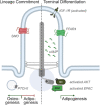Primary Cilia Are Critical Regulators of White Adipose Tissue Expansion
- PMID: 34759842
- PMCID: PMC8573240
- DOI: 10.3389/fphys.2021.769367
Primary Cilia Are Critical Regulators of White Adipose Tissue Expansion
Abstract
The primary cilium is a microtubule-based cellular protrusion found on most mammalian cell types in diverse tissues. It functions as a cellular antenna to sense and transduce a broad range of signals, including odorants, light, mechanical stimuli, and chemical ligands. This diversity in signals requires cilia to display a context and cell type-specific repertoire of receptors. Recently, primary cilia have emerged as critical regulators of metabolism. The importance of primary cilia in metabolic disease is highlighted by the clinical features of human genetic disorders with dysfunctional ciliary signaling, which include obesity and diabetes. This review summarizes the current literature on the role of primary cilia in metabolic disease, focusing on the importance of primary cilia in directing white adipose tissue expansion during obesity.
Keywords: adipogenesis; diabetes; obesity; primary cilia; signaling.
Copyright © 2021 Hilgendorf.
Conflict of interest statement
The author declares that the research was conducted in the absence of any commercial or financial relationships that could be construed as a potential conflict of interest.
Figures


References
Publication types
LinkOut - more resources
Full Text Sources

